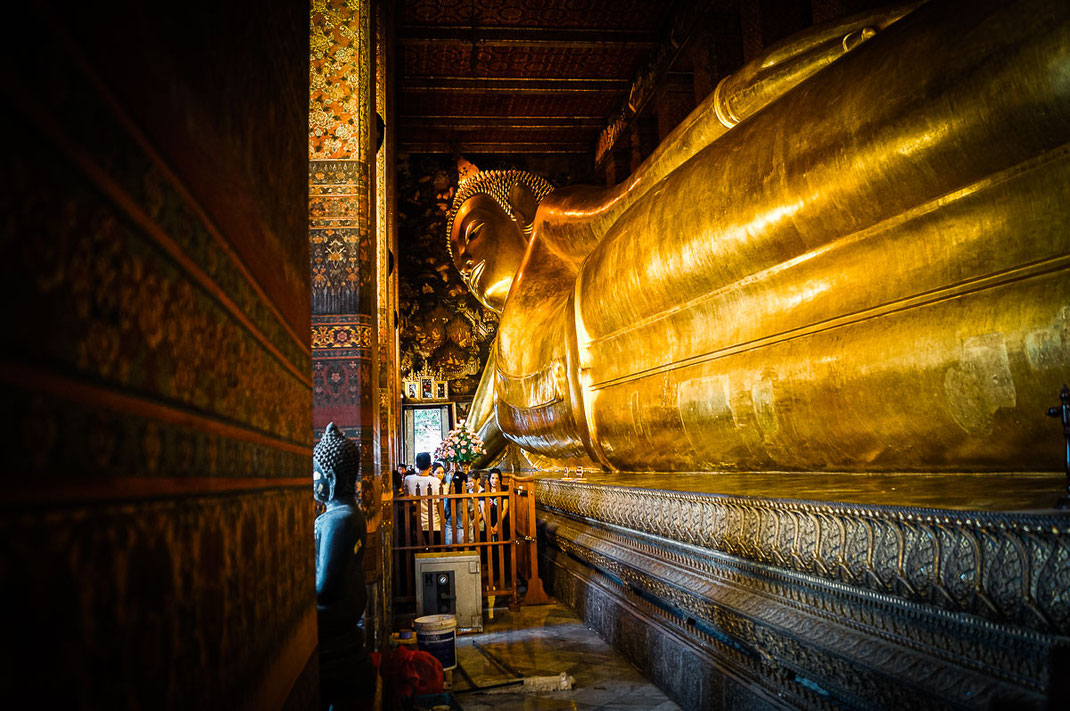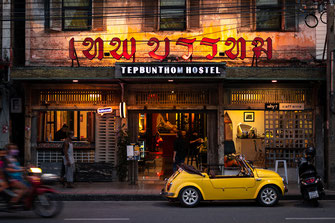🌐 »

Wat Pho, which is famous for its reclining Buddha, was to be our first insight into the foreign culture of Southeast Asia. After an 18-hour international flight, we landed in Bangkok in the morning and checked into our hotel, which would be our base for the next three days. We then made our way on foot to the temple, which is located in the center of the historic old town. Nearby is also the Royal Palace, which we wanted to visit afterwards.
Our first stay in Asia and then immediately in the mega-metropolis of Bangkok. We set off from the hotel and immersed ourselves in the vibrant streets, lined with food stalls and spanned by power cables, through which honking scooters and pickup trucks jostled. We strolled cautiously through the alleyways of this huge city and sank into another world. If you've never been to a big city outside Europe, it's probably hard to imagine, but it really is a different world. We reached the gates of the temple and fortunately did not suffer a culture shock on our first few meters on foreign soil.
Once at the entrance, an entrance fee of 100 baht (~ €3) per person must be paid. In general, the temple complex is open from 08:00 to 18:30 and every visitor is given a free bottle of water at the beginning, which can be refilled on site. Wat Pho attracts around 10,000 visitors a day, so it can get quite crowded at peak times, especially at lunchtime. We were there in the late afternoon, and even at this time there was still a lot of traffic. For this reason, it is advisable to visit the complex early in the morning or in the evening, just before the ticket office closes. As Wat Pho is a Buddhist temple, a few dress rules should be observed. Shorts, crop tops and skimpy dresses should be left in the wardrobe out of respect for the culture.
You will reach the reclining Buddha shortly after the entrance. It is located on the right-hand side in a temple and when you step through its doors, you will see the statue in all its glory. The Buddha measures 46 meters in total and is 15 meters high. Its interior is made of stone and plaster and for the 60th birthday of King Bhumibol, the Buddha was completely covered in gold leaf. There are also 108 symbols made of ivory on the soles of the feet. These have both a royal and a mythological meaning. There are 108 alms bowls to match the motifs, as it is said to bring good luck to throw a coin into each of the bowls. If you need the right change for this, you can buy coins at the cash desk. The size of the Buddha is impressive and as it is located in a building that almost seems too small for the statue, it is almost impossible to get a picture of it.


But the rest of the temple complex, which was built in the 17th century, is also well worth seeing. In the magnificently decorated inner courtyard there are four tile-covered chedis, each 42 meters high. Chedis are bell-shaped towers that are called stupas in other countries, such as Indonesia, and are part of a wat, a Buddhist temple complex in Thailand. If you stroll a little further across the grounds, you will come across four chapels with a total of 394 gilded Buddhas. During our stay, numerous locals formed towers, pyramids and chedis out of sand and decorated them with flags. A monk sat in the shade with a Coke.




After an hour, we had explored every corner of the complex and made our way to the Royal Palace, which is just around the corner. However, the king was there that very day and so the palace was closed. For this reason, the palace had to wait another day for us!



